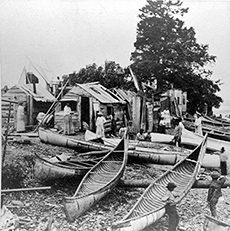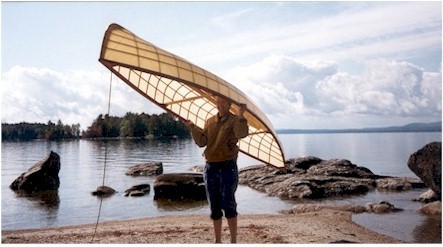The Course
We are posting here an account of our canoe building project, part of a one semester class for high school seniors. The course focuses on the cultural history and geography of coastal Maine. We chose the canoe as a central part of the course because of its important place in the earliest settlement of the coast by Native Americans and its resurgence in Maine's recent history as a means of recreation. Students will build the canoes this spring and then use them on a trip along the Maine coast at the end of the course.

Indian encampment in Bar Harbor, 1881. Stereoview by Kilburn Brothers.
The Boats
The model of touring canoe we are building was designed in the early 1980's by Platt Monfort, who lived along the Sheepscot River in Westport, Maine. Monfort started with the original shape and concept of the birch bark canoe which startled early European visitors to the New England coast because of its light weight construction and ease of paddling. Monfort designed his canoes around the construction principles of the Maine peapod, a double ended fishing boat, with oak stems, knees, a keel with moderate rocker and a gunwale-rib-inwale sandwich. But his boats are much lower than traditional canoes and peapods, like the Rushton canoes from the 1890's, with a deep sheer to allow a paddler to use a double paddle in a seated position.
The biggest innovations Monfort added to canoe design were the use of aircraft dacron wrapped over a very lightweight set of stringers and longitudinal stiffening through the use of kevlar roving, techniques employed in the construction of light aircraft and gliders. His 14' boats often weigh as little as 20 pounds, half the weight of a similar boat built in fiberglass or aluminum. His work represents the unusual blend of tradition and innovation that has characterized Maine's boatbuilding industry over the past forty years with the introduction of epoxies and hybrid materials like carbon fiber and kevlar to a long standing traditions in wood construction.
 |
| Platt Monfort's Geodesic Airolite Canoe |
Our Shop
We are using a 24' square classroom, most often used as an art studio. We have access to a very well-equipped wood shop down the hall with a table saw, chop saw, and band saw - and the advice of the master craftsman who teaches there - but we only use the shop on weekends or evenings as it regularly serves as many as fifty students during the class day. While power saws are important for ripping the stringers and ribs and fashioning knees, thwarts, stems, and floorboards, most of the boat's fabrication depends on small pull saws, rasps, and various clamping devices. With the loan of a table saw to do the ripping of most parts and a jig saw to cut the stems, knees, and thwart gussets, this project is feasible for groups with modest means.
 |
| Strong backs under construction |
Beginning
We began our canoe building project by constructing 8 strong backs out of 1x8 pine we purchased from a local box maker. We set an early goal of trying to build as inexpensively as possible and with the fewest power tools so that we could model the project for schools and groups with limited shop access. The boards came in 14' lengths so required no cutting. While many of them warped more than plywood would have done, we built using a system of stanchions that allowed us to correct the alignment of the station molds to overcome irregularities in the 1x8's. Scrap plywood spacers helped us align the boards and 15/8 drywall screws held the assembly together.
No comments:
Post a Comment